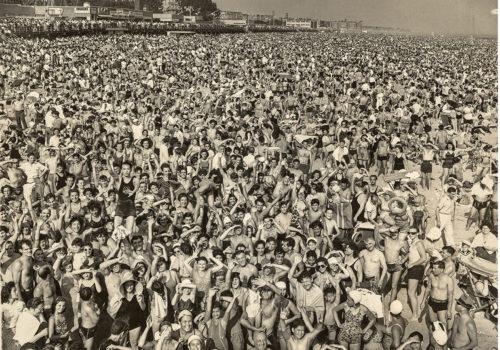The Fondation Henri Cartier-Bresson presents Weegee : Autopsie du Spectacle.
There is a Weegee conundrum. The American photographer’s career seems to be split in two. First of all, the shocking clichés published in the North American tabloid press: corpses of gangsters lying in their blood, bodies inbedded in crushed vehicles, sinister-looking little gang leaders behind the bars of a police van, dilapidated slums burning down and some other poignant documents on the life of the most deprived in New York between 1935 and 1945.
Then there are festive images – social evenings, acrobat shows, jubilant crowds, openings and premieres – to which must be added a plethora of portraits of public figures that the photographer had fun distorting through a very rich palette of tricks between 1948 and 1951, which he continued to shoot until the end of his life. How can these two bodies of work, so diametrically opposed, coexist within the same photographic work? Exegetes have taken pleasure in reinforcing the opposition between these two periods, praising the first and detesting the second. The exhibition Autopsie du Spectacle aims to reconcile the two Weegees by showing that beyond the differences in form, the photographer’s approach is based on real critical coherence.
The question of spectacle is omnipresent in Weegee’s work. In the first part of his career, which historically corresponds to the rise of the tabloid press, he participated in the transformation of news stories into spectacle.
To show this clearly, he often includes spectators or other photographers in the foreground of his images.
In the second half of his career, Weegee mocked the Hollywood spectacular: the ephemeral glories, the crowds that adored them and the worldliness that surrounded them. A few years before the Situationist International, through his photographs he offered an incisive critique of the Society of the Show business.
A new reading of Weegee’s work, Autopsie du Spectacle presents icons of the photographer alongside lesser-known images never before shown in France.
Exhibition curator
Clément Chéroux
Director, Henri Cartier-Bresson Foundation
“Weegee is neither the only one nor the first to be interested in the onlookers in this way. Shortly before him, in 1937, Henri Cartier-Bresson had photographed the spectators attending the coronation of George VI for Ce Soir. A quarter of a century earlier, in 1912, Eugène Atget had also photographed passers-by observing a solar eclipse on the Place de la Bastille in Paris. But Weegee takes the idea even further.
He systematizes it. He makes it a principle that he does not hesitate to implement whenever the opportunity arises. This is a form of distancing. It’s about pushing the reader to question the way in which they look and to make it clear that he finds himself, like the spectator in the image, in a situation of voyeurism. There is also a form of criticism of the way in which American society transforms the news into shows. “ – Clément Chéroux
Weegee was born Usher Felig on June 12, 1899, to a Jewish family in Zolochiv, a small town in Galicia that was then part of the Austro-Hungarian Empire and is now located in western Ukraine. At the age of 11, he joined his father who had emigrated to the United States. At the Ellis Island immigration office, he became Arthur Fellig. Installed in the poor neighborhoods of the Lower East Side, he left school at 14 and began working to help his family. After practicing different professions, he became a traveling photographer, working for the photographers Duckett & Adler then in the laboratories of the ACME Newspictures agency. From 1935, he became self-employed as a photo reporter. Around 1937, he began using the pseudonym Weegee, then, around 1941, marking the back of his prints with a stamp in the shape of a self-fulfilling prophecy: “Weegee the Famous”. For 10 years, connected to the police radio, he photographed, mainly at night, crimes, arrests, fires, accidents and other news items. The photographer certainly had connections with the police, without whom he would not have been able to work, but he also frequented a lot of left-wing circles. He was very close to the Photo League, this group of independent photographers who firmly believed in emancipation through images and campaigned for social justice. In 1945, he brought together his best photographs in a book entitled Naked City, which met with real esteem and sales success. Weegee then started to be well known. In the spring of 1948, he moved to Hollywood where he worked for the film industry as a technical advisor and sometimes also as an actor. He photographed the permanent parties and developed various photographic trick techniques with which he caricatured celebrities. In December 1951, after four years on the West Coast, he returned to New York but did not return to his old practice. Until his death on December 26, 1968, most of his activity consisted of taking advantage of his notoriety to publish other books, go on speaking tours and widely distributed his photo-caricatures in the press.
Weegee, Autopsie du Spectacle
January 30 – May 19, 2024
Fondation Henri Cartier-Bresson
79 rue des Archives 75003 Paris
+33 (0)1 40 61 50 50
www.henricartierbresson.org
@FondationHCB
The exhibition is accompanied by a catalog in French published by Éditions Textuel.
Weegee, Autopsie du Spectacle
Textual Éditions
Texts by Isabelle Bonnet, David Campany, Clément Chéroux and Cynthia Young.
20 x 26 cm
208 pages
Publication: January 17, 2024
ISBN 978-2-84597-990-1
€55
www.editionstextuel.com
The exhibition Autopsie du Spectacle will also be shown from September 24, 2024 to January 5, 2025 at the Fundación MAPFRE (Madrid, Spain). A catalog in Spanish will be published on this occasion.
















